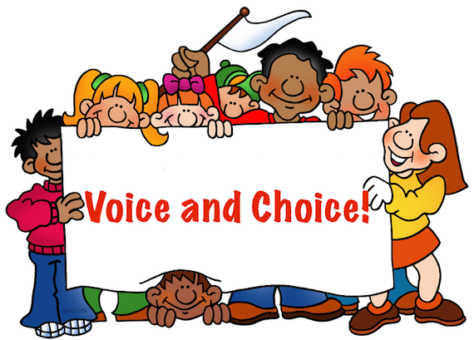How Voice and Choice Evolved in My Classroom
Student voice and choice are popular topics on teacher social media these days. Educators are paying more attention to student input as we plan our learning tasks. But it wasn’t always that way.
I remember back to when I was a student in junior high – it was a drama class and my friends and I wanted to write and perform our own play about junior high life.
In today’s world of education I think most of us would jump on the opportunity for students to exercise these creative muscles and have the chance to share their voices in a public way. Unfortunately, that was not my junior high experience. We were told we would do a certain play, it would be directed by our teacher, and we would be happy with it.
This was a common thread in all of my classes. The novel studies. The endless pages of questions in a workbook. Being assigned five pages of problems in our math text. (We were lucky if we only had to do the odd or even questions.)
Twenty years ago (yikes – it really has been 20!), education was very much teacher driven and very much sit and get. When I found myself in college, preparing to be a teacher myself, I was determined I’d give my students more choice and more opportunity to guide themselves.
It has been a quite a journey over the last nine years and I’m still not completely there, but with the help of my students, we are doing a lot more student-driven learning than I could have ever imagined back in my adolescent days.
It all started in third grade
Nine years ago, I walked into my first classroom – grade 3. I wanted to raise little activists. Our social studies curriculum was all about the world – we looked at the rights of children, we discussed different cultures and current events. It was also the same year the Arab Spring began.
That year, as a new teacher, I could have met expectations if I’d taught using the workbooks offered by the veteran teachers in my pod. I could have given my students a booklet that had the Tunisian Flag to color, word searches for terms that they “needed” to know, and some cute clipart-covered “fact collectors” for them to fill out as they went through their text books.
I could have done all of those things and everyone would have been satisfied, but I decided that I wanted to explore the big wide world with these eight-year olds. I decided that we needed to look at some of what was going on and talk about why.
So in our primary grades classroom we started having some serious discussions. We talked about why people in other countries were unhappy enough to rise up. We talked about the rights we have in Canada that keep us protected and how other countries are fighting for those same rights. We talked about why it is hard to become a democracy.
Then something funny happened. Students started bringing in topics of their own. They wanted to talk about natural disasters in Haiti, the food supply crisis in India, earthquakes in Japan. We kept talking, we shared what we could find out, and my students started to see “others” as people they had empathy for.
The power of our simple morning conversations as we gathered in a circle directed our learning in a far more authentic and powerful way than any text book could ever do.
A troubling pattern in the upper grades
I continued this thinking about student-empowered learning as I grew as a teacher. But as I moved up to teach in higher grades, I noticed a troubling pattern.
My students talked less. I would bring up an issue, a topic for discussion, and would often be greeted with silence. A few students would offer a point here and there, but the majority would masterfully avoid eye contact. When they put up a hand, I would excitedly call on them and be sadly disappointed when they asked to get a drink of water or go to the bathroom.
The problem, I concluded, was that conversation had simply been taught out of them.
So I started looking for ways to bridge the gap, ways to promote discussion. I moved out of Social Studies and into Language Arts about this time. I began absorbing the insights of teacher thought leaders like Pernille Ripp and Kelly Gallagher and professional learning experts like Kylene Beers and Penny Kittle. I started to look into conferencing with students — conversations on a smaller scale.
Leveling up toward deeper conversations
Then I read Disrupting Thinking by Kylene Beers and Bob Probst and was reenergized about the importance of having my students learn to react to the things they read — why students need to question and pick apart texts — to internalize and deepen their understanding and then share that thinking.
Regardless of their age, students are not too young to learn to defend their position when it is defensible and to change it when new information, insight, or reasoning persuades them.” – Beers & Probst
We started easy with their Book-Head-Heart framework to get our ideas down on the page, and then we shared. Utilizing accessible texts from sites like Newsela and CommonLit, my students were asked to read and respond first in writing and then in discussion.
There was some progress, but still the portals to deeper understanding were only partially open. Discovering Marisa Thompson’s TQE Method moved me to the next level. Most important for me was her suggestion that we let students talk first in small groups and develop the best points of discussion before sharing out to the whole class.
This technique really led to some great conversation and opened doors for my students to share their voices. The next step was to activate that classroom I have always wanted — one based on voice and choice.
What about our own lives?
One day while looking at an article a student asked, “Mr.G, why are we talking about this? It has nothing to do with us.”
He had a point. I was asking my students to respond to issues out in the wide world and forgetting to have them respond to issues closer to home in the world they see every day through their rural Canadian windows. The next week we looked at an article about farm safety (their world) and the discussions were rich and passionate.
By providing options for my students (choice), a chance to think about and discuss the topic (TQE), and the opportunity to share in the way they are comfortable (voice), I have started building a classroom where conversations are the centerpiece.
Our classroom conversations have begun to steer the actual workings of the room. Students who were tired of not taking the lead in their learning have helped plan their own inquiry projects. Along the way, we discuss what is working and what is not. We talk about next steps.
This process has not been easy and is constantly adjusting to how my students are thinking and feeling. But the constant is the conversations. When we trust our students to talk about what matters to them, about what they’re learning and how they go about learning, we are empowering them to make choices for themselves.
When students learn to advocate for themselves as learners, we begin to change the system at the deep roots.
______________
Brent Gilson (@mrbgilson) is in his 9th year of teaching. He began his career in a third grade classroom and has since spent time in grades 4,6,7 and 8. Brent currently teaches at the middle level in a small community in southern Alberta, Canada. He enjoys talking books with his students and writing for his blog thingsmrgsays.com and occasionally recording a podcast. Watch for more of Brent’s posts here at MiddleWeb in the coming school year.






































